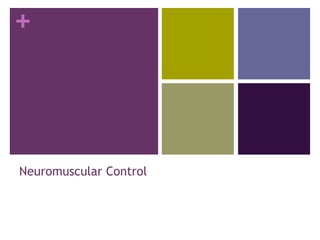Neuromuscular control
•Descargar como PPTX, PDF•
0 recomendaciones•1,677 vistas
Denunciar
Compartir
Denunciar
Compartir

Recomendados
Recomendados
A 3 part system –
- Mechanical interface – a/k/s – nerve bed – consist of bone, tendon, muscle, Ivdisc, ligaments, fascia, blood vessels.
- Neural structures – brain, nerve roots, C.N, peripheral nerves, spinal cord
- Innervated tissues – all tissues which are innervated by nervous system.
Neural tissue mobilization

Neural tissue mobilizationDr. Vitthalrao Vikhe Patil Foundation's College of Physiotherapy, Ahmednagar
Más contenido relacionado
La actualidad más candente
A 3 part system –
- Mechanical interface – a/k/s – nerve bed – consist of bone, tendon, muscle, Ivdisc, ligaments, fascia, blood vessels.
- Neural structures – brain, nerve roots, C.N, peripheral nerves, spinal cord
- Innervated tissues – all tissues which are innervated by nervous system.
Neural tissue mobilization

Neural tissue mobilizationDr. Vitthalrao Vikhe Patil Foundation's College of Physiotherapy, Ahmednagar
La actualidad más candente (20)
Similar a Neuromuscular control
The Indian Dental Academy is the Leader in continuing dental education , training dentists in all aspects of dentistry and
offering a wide range of dental certified courses in different formats.for more details please visit
www.indiandentalacademy.comNeuro anatomy and physiology of masticatory system/certified fixed orthodonti...

Neuro anatomy and physiology of masticatory system/certified fixed orthodonti...Indian dental academy
The Indian Dental Academy is the Leader in continuing dental education , training dentists in all aspects of dentistry and offering a wide range of dental certified courses in different formats.
Indian dental academy provides dental crown & Bridge,rotary endodontics,fixed orthodontics,
Dental implants courses.for details pls visit www.indiandentalacademy.com ,or call
0091-9248678078Neuro anatomy and physiology of masticatory system /certified fixed orthodont...

Neuro anatomy and physiology of masticatory system /certified fixed orthodont...Indian dental academy
Similar a Neuromuscular control (20)
Chapter 1 structure and function of the muscular, neuromuscular, cardiovasc...

Chapter 1 structure and function of the muscular, neuromuscular, cardiovasc...
Human nervous system for allied health students.ppt

Human nervous system for allied health students.ppt
Neuro anatomy and physiology of masticatory system/certified fixed orthodonti...

Neuro anatomy and physiology of masticatory system/certified fixed orthodonti...
Neuro anatomy and physiology of masticatory system /certified fixed orthodont...

Neuro anatomy and physiology of masticatory system /certified fixed orthodont...
Más de trieducation
Más de trieducation (20)
Neuromuscular control
- 2. + Key Concepts It is important to understand the microscopic structure of skeletal muscle and how these structures assist with creating movement. Muscles create movement by pulling on the bone to which they attach. In order to do this, messages are sent from the brain to the muscles to initiate movement. Muscles coordinate in pairs to produce coordinated movement
- 4. + A motor unit A motor unit consists of one motor neuron and the muscle fibre it stimulates (Each neuron may stimulate a number of muscle fibres) Depending on the size and function of a muscle will depend on the number of motor units it has Example: The quadriceps is responsible for gross movement such as kicking and jumping. It has a very large number of motor units The muscles that control movements like writing and typing have only a small number of motor units.
- 6. + The ‘all or nothing’ principle The nerve impulse will not stimulate the muscle fibres until it reaches a certain threshold level. Once the nerve impulse reaches this threshold, all fibres of the motor unit will contract at the same time and maximally. If the impulse is too weak, no fibres will contract. Therefore depending on the force required for a movement will impact the number and speed of nerve impulses sent.